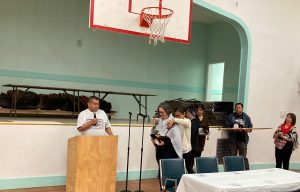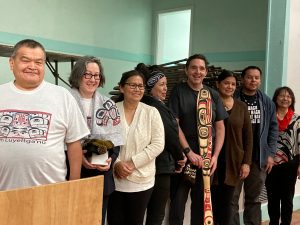Monday, October 23 twenty-five years of cooperative community-based research was celebrated in Lach Klan, Gitxaała. The diner was hosted by hagwil hayetsk (Charles Menzies) on behalf of UBC. Dr Clare Crowston, Dean of Arts, UBC-V was there on behalf of UBC to acknowledge the work and support and involvement of Gitxaała community members in the project. The dinner also marked the end of Charles’ active in-community research.
Speaking notes, hagwil hayetsk.
Over the past 25yrs five of my academic research projects have been done in collaboration with people from Gitxaala. This amounts to about one third of my academic research. Another third has been with fisherfolk in France and Ireland. The other third about settler society.
Doing research with Gitxaala has allowed me to connect with and be in service to my ancestral community. Beginning research in this territory 25 years ago was an important homecoming for me both personally and professionally.
All the Gitxaala related projects focused on natural resources: forestry, fisheries, and traditional food harvesting. All focused on the importance and relevance of Gitxaala knowledge for shaping forests and oceans. This reflects my family’s connection to commercial fishing and my own experiences on the water.
Our first projects, starting in 1997 were forestry. The first documented Tsimshian involvement in the forest industry. The second focused on how local ecological knowledge could inform natural resource management practices.
In 2004 we started a series of climate change projects. One part of this involved collecting and analyzing ancient pollen from Banks Island. Teddy Gamble took me and a field assistant down to Patsy Cove where we hiked into the bog to take samples. While we did that Teddy had to run to Heavener Inlet to anchor.
In 2008 we began a project focused on fish traps & villages in Gitxaala territory by appropriating archaeological methods. This phase of research lasted almost a decade.
Having always been beguiled by mountain goats -Mati – we began a project exploring mati territory on Pitt Island in 2017, a project that has now drawn to a close. The end of mati project work has inspired this event. It has always been a part of the collaborative process between UBC and Gitxaala to mark the milestones of our partnership. This is the third time that UBC leadership has come to witness a celebration of our research.
This dinner acknowledges Gitxaala as a community, this is UBC expressing appreciation for 25 years of cooperative research. It is also a moment for me to acknowledge all the hard work of the community over these years and some of the people who have been pivotal in this. I am unable to name everyone as so many people have been involved in so many different ways.
When I first came home, I was welcomed, taught, and mentored by family and community. I acknowledge that support, that care, that was given to me. Being among family and friends has provided a haven when the world of the university was less hospitable.
Billy Gamble and Vonnie Hutchinson have been a steady support. On my first visit ashore in Lach Klan Vonnie put me up and took me round to meet family who welcomed me home.
Smoygyet He:l, Russell Gamble, shared his time with me.
I grew up with stories about K’moda and then was fortunate to be able to be there with He:l, Teddy Gamble, and my father 20 years ago. It was a privilege to hear those three men talk about that place. I had been there many times before on my father’s boat, but that time with the three of them was special.
Merle and Ernie Bolton have hosted many students over the years. They have also provided me and my colleagues with advice and encouragement. This event in particular relied on Merle’s tireless support. Ernie has also provided Sm’algyax expertise and insight that have been so important to understanding how our language and territory are interwoven. We have relied on him heavily over the years.
Over the years UBC students, community researchers, and I have spoken to many people about research. More than one dozen UBC graduate students wrote their theses and project reports on their research with Gitxaala community members. Much of this research has been done alongside of Caroline Butler who started as a student researcher and then made the north coast her home. Caroline and I have been blessed with mentors who have been patient with us as we each learned to be the persons we are today.
During the archaeological research, I was often on a boat skippered by Teddy Gamble and crewed -at different times- by Vince Davis, Tim Innes, Philip Gamble, and Russ Gamble. Along with us were community researchers including among them Greg McKay and Ken Innes.
Sam Lewis, Raven McMahon and Clayton Hill were community researchers who helped us to develop the team-based method that has been the foundation of the work. Cyril Aster has also supported many of the students in their learning about food harvesting and processing.
The Elders and hereditary leaders of Gitxaala have been the most important guides in this work. Each of the Elders of this Nation has contributed to this work in some way – through providing their knowledge in interviews, providing feedback in meetings, or identifying research needs and priorities. Their knowledge and expertise is the foundation of this work.
During these years there have been many council members who have taken an interest in the UBC/Gitxaala cooperative research project. Soon after the project began Clifford White was elected Chief Councilor. This was also at a moment when development in the Port of Prince Rupert intensified. Clifford, and then subsequent councils, asked me to prepare a series of reports, background documents, and expert opinions in support of Gitxaala Laxyuup.
I have during these years found myself working on reports for Gitxaala about underwater power lines, wind turbines, tar sand pipelines, oil and gas tanker routes, and mineral claims. Clarence Innis, as councilor and hereditary leader was often there supporting this work through his advice and mentorship.
As I stand here today, in this hall, I remember the words of the late smoygyet He:l, speaking here at the reopening ceremony in 2004. He spoke about the strength of this community, the things that this community has accomplished and would accomplish through working together as one.
This dinner celebrates one small bit of that strength, a strength that made this research collaboration a reality for twenty-five years.


